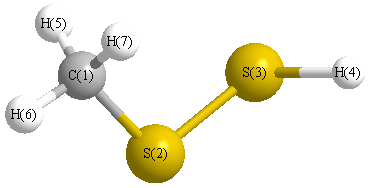Vibrational Frequencies calculated at HF/6-31+G**
| Mode Number |
Symmetry |
Frequency
(cm-1) |
Scaled Frequency
(cm-1) |
IR Intensities
(km mol-1) |
Raman Act
(Å4/u) |
Dep P |
Dep U |
|---|
| 1 |
A |
3309 |
2992 |
9.23 |
66.66 |
0.75 |
0.86 |
| 2 |
A |
3293 |
2978 |
8.16 |
90.39 |
0.74 |
0.85 |
| 3 |
A |
3204 |
2897 |
27.66 |
134.09 |
0.02 |
0.04 |
| 4 |
A |
2870 |
2595 |
7.01 |
156.38 |
0.34 |
0.50 |
| 5 |
A |
1603 |
1449 |
9.82 |
9.12 |
0.70 |
0.83 |
| 6 |
A |
1586 |
1434 |
9.09 |
14.13 |
0.75 |
0.86 |
| 7 |
A |
1495 |
1352 |
6.06 |
0.76 |
0.63 |
0.77 |
| 8 |
A |
1082 |
979 |
8.75 |
3.86 |
0.31 |
0.47 |
| 9 |
A |
1074 |
971 |
1.21 |
2.14 |
0.75 |
0.86 |
| 10 |
A |
990 |
895 |
12.16 |
16.01 |
0.67 |
0.80 |
| 11 |
A |
769 |
695 |
1.87 |
22.85 |
0.38 |
0.55 |
| 12 |
A |
558 |
505 |
1.03 |
35.48 |
0.24 |
0.38 |
| 13 |
A |
322 |
291 |
22.79 |
1.61 |
0.75 |
0.86 |
| 14 |
A |
262 |
237 |
0.09 |
4.43 |
0.57 |
0.73 |
| 15 |
A |
190 |
172 |
0.68 |
0.13 |
0.75 |
0.86 |
Unscaled Zero Point Vibrational Energy (zpe) 11303.2 cm
-1
Scaled (by 0.9042) Zero Point Vibrational Energy (zpe) 10220.4 cm
-1
See section
III.C.1 List or set vibrational scaling factors
to change the scale factors used here.
See section
III.C.2
Calculate a vibrational scaling factor for a given set of molecules
to determine the least squares best scaling factor.
Charges, Dipole, Quadrupole and Polarizability
Charges from optimized geometry at HF/6-31+G**
Charges (e)
| Number |
Element |
Mulliken |
CHELPG |
AIM |
ESP |
| 1 |
C |
-0.463 |
|
|
|
| 2 |
S |
-0.016 |
|
|
|
| 3 |
S |
-0.074 |
|
|
|
| 4 |
H |
0.057 |
|
|
|
| 5 |
H |
0.172 |
|
|
|
| 6 |
H |
0.162 |
|
|
|
| 7 |
H |
0.162 |
|
|
|
Electric dipole moments
Electric dipole components in Debye
(What's a Debye? See section
VII.A.3)
| |
x |
y |
z |
Total |
| |
-1.161 |
1.451 |
1.034 |
2.126 |
| CHELPG |
|
|
|
|
| AIM |
|
|
|
|
| ESP |
|
|
|
|
Electric Quadrupole moment
Quadrupole components in D Å
| Primitive |
|---|
| | x | y | z |
|---|
| x |
-31.601 |
-0.523 |
2.119 |
| y |
-0.523 |
-36.007 |
0.763 |
| z |
2.119 |
0.763 |
-33.823 |
|
| Traceless |
|---|
| | x | y | z |
|---|
| x |
3.314 |
-0.523 |
2.119 |
| y |
-0.523 |
-3.295 |
0.763 |
| z |
2.119 |
0.763 |
-0.019 |
|
| Polar |
|---|
| 3z2-r2 | -0.039 |
|---|
| x2-y2 | 4.406 |
|---|
| xy | -0.523 |
|---|
| xz | 2.119 |
|---|
| yz | 0.763 |
|---|
|
Polarizabilities
Components of the polarizability tensor.
Units are
Å
3 (Angstrom cubed)
Change units.
| |
x |
y |
z |
| x |
8.984 |
0.296 |
0.207 |
| y |
0.296 |
6.295 |
0.086 |
| z |
0.207 |
0.086 |
5.562 |
<r2> (average value of r
2) Å
2
| <r2> |
102.656 |
| (<r2>)1/2 |
10.132 |
